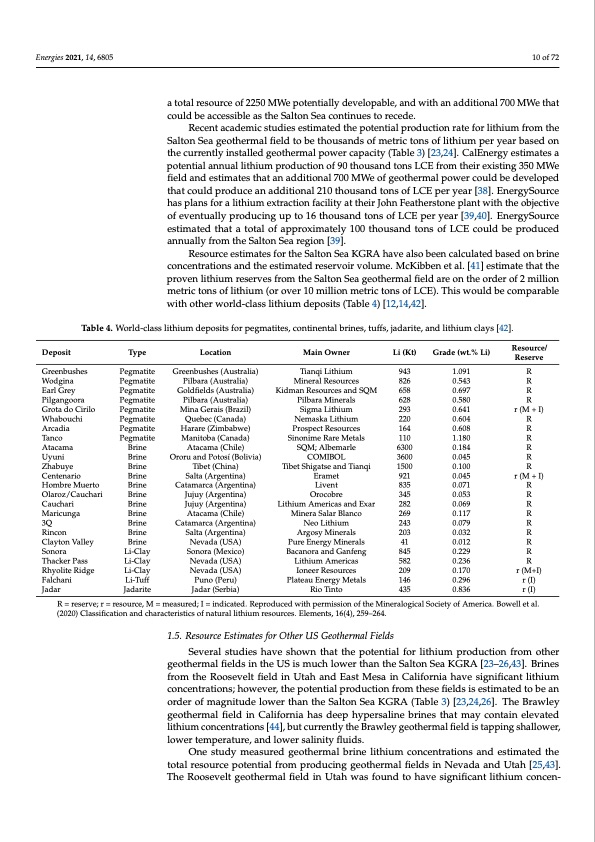
PDF Publication Title:
Text from PDF Page: 010
Energies 2021, 14, 6805 10 of 72 Deposit Greenbushes Wodgina Earl Grey Pilgangoora Grota do Cirilo Whabouchi Arcadia Tanco Atacama Uyuni Zhabuye Centenario Hombre Muerto Olaroz/Cauchari Cauchari Maricunga 3Q Rincon Clayton Valley Sonora Thacker Pass Rhyolite Ridge Falchani Jadar Type Pegmatite Pegmatite Pegmatite Pegmatite Pegmatite Pegmatite Pegmatite Pegmatite Brine Brine Brine Brine Brine Brine Brine Brine Brine Brine Brine Li-Clay Li-Clay Li-Clay Li-Tuff Jadarite Location Greenbushes (Australia) Pilbara (Australia) Goldfields (Australia) Pilbara (Australia) Mina Gerais (Brazil) Quebec (Canada) Harare (Zimbabwe) Manitoba (Canada) Atacama (Chile) Ororu and Potosí (Bolivia) Tibet (China) Salta (Argentina) Catamarca (Argentina) Jujuy (Argentina) Jujuy (Argentina) Atacama (Chile) Catamarca (Argentina) Salta (Argentina) Nevada (USA) Sonora (Mexico) Nevada (USA) Nevada (USA) Puno (Peru) Jadar (Serbia) Main Owner Tianqi Lithium Mineral Resources Kidman Resources and SQM Pilbara Minerals Sigma Lithium Nemaska Lithium Prospect Resources Sinonime Rare Metals SQM; Albemarle COMIBOL Tibet Shigatse and Tianqi Eramet Livent Orocobre Lithium Americas and Exar Minera Salar Blanco Neo Lithium Argosy Minerals Pure Energy Minerals Bacanora and Ganfeng Lithium Americas Ioneer Resources Plateau Energy Metals Rio Tinto Li (Kt) 943 826 658 628 293 220 164 110 6300 3600 1500 921 835 345 282 269 243 203 41 845 582 209 146 435 Grade (wt.% Li) 1.091 0.543 0.697 0.580 0.641 0.604 0.608 1.180 0.184 0.045 0.100 0.045 0.071 0.053 0.069 0.117 0.079 0.032 0.012 0.229 0.236 0.170 0.296 0.836 Resource/ Reserve R R R R r (M + I) R R R R R R r (M + I) R R R R R R R R R r (M+I) r (I) r (I) a total resource of 2250 MWe potentially developable, and with an additional 700 MWe that could be accessible as the Salton Sea continues to recede. Recent academic studies estimated the potential production rate for lithium from the Salton Sea geothermal field to be thousands of metric tons of lithium per year based on the currently installed geothermal power capacity (Table 3) [23,24]. CalEnergy estimates a potential annual lithium production of 90 thousand tons LCE from their existing 350 MWe field and estimates that an additional 700 MWe of geothermal power could be developed that could produce an additional 210 thousand tons of LCE per year [38]. EnergySource has plans for a lithium extraction facility at their John Featherstone plant with the objective of eventually producing up to 16 thousand tons of LCE per year [39,40]. EnergySource estimated that a total of approximately 100 thousand tons of LCE could be produced annually from the Salton Sea region [39]. Resource estimates for the Salton Sea KGRA have also been calculated based on brine concentrations and the estimated reservoir volume. McKibben et al. [41] estimate that the proven lithium reserves from the Salton Sea geothermal field are on the order of 2 million metric tons of lithium (or over 10 million metric tons of LCE). This would be comparable with other world-class lithium deposits (Table 4) [12,14,42]. Table 4. World-class lithium deposits for pegmatites, continental brines, tuffs, jadarite, and lithium clays [42]. R = reserve; r = resource, M = measured; I = indicated. Reproduced with permission of the Mineralogical Society of America. Bowell et al. (2020) Classification and characteristics of natural lithium resources. Elements, 16(4), 259–264. 1.5. Resource Estimates for Other US Geothermal Fields Several studies have shown that the potential for lithium production from other geothermal fields in the US is much lower than the Salton Sea KGRA [23–26,43]. Brines from the Roosevelt field in Utah and East Mesa in California have significant lithium concentrations; however, the potential production from these fields is estimated to be an order of magnitude lower than the Salton Sea KGRA (Table 3) [23,24,26]. The Brawley geothermal field in California has deep hypersaline brines that may contain elevated lithium concentrations [44], but currently the Brawley geothermal field is tapping shallower, lower temperature, and lower salinity fluids. One study measured geothermal brine lithium concentrations and estimated the total resource potential from producing geothermal fields in Nevada and Utah [25,43]. The Roosevelt geothermal field in Utah was found to have significant lithium concen-PDF Image | Recovery of Lithium from Geothermal Brines

PDF Search Title:
Recovery of Lithium from Geothermal BrinesOriginal File Name Searched:
energies-14-06805-v2.pdfDIY PDF Search: Google It | Yahoo | Bing
Product and Development Focus for Infinity Turbine
ORC Waste Heat Turbine and ORC System Build Plans: All turbine plans are $10,000 each. This allows you to build a system and then consider licensing for production after you have completed and tested a unit.Redox Flow Battery Technology: With the advent of the new USA tax credits for producing and selling batteries ($35/kW) we are focussing on a simple flow battery using shipping containers as the modular electrolyte storage units with tax credits up to $140,000 per system. Our main focus is on the salt battery. This battery can be used for both thermal and electrical storage applications. We call it the Cogeneration Battery or Cogen Battery. One project is converting salt (brine) based water conditioners to simultaneously produce power. In addition, there are many opportunities to extract Lithium from brine (salt lakes, groundwater, and producer water).Salt water or brine are huge sources for lithium. Most of the worlds lithium is acquired from a brine source. It's even in seawater in a low concentration. Brine is also a byproduct of huge powerplants, which can now use that as an electrolyte and a huge flow battery (which allows storage at the source).We welcome any business and equipment inquiries, as well as licensing our turbines for manufacturing.| CONTACT TEL: 608-238-6001 Email: greg@infinityturbine.com | RSS | AMP |